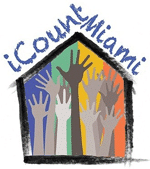 Bobbie Ibarra, Executive Director of the Miami Coalition for the Homeless, and Carla Silva, Executive Director of The Alliance for GLBTQ Youth, are members of iCount Miami and leaders in their communities. We spoke with Bobbie and Carla about the strategies behind the August count and the challenges the coalition faced. They had a lot to share about the importance of collaboration, planning, and youth involvement.
Bobbie Ibarra, Executive Director of the Miami Coalition for the Homeless, and Carla Silva, Executive Director of The Alliance for GLBTQ Youth, are members of iCount Miami and leaders in their communities. We spoke with Bobbie and Carla about the strategies behind the August count and the challenges the coalition faced. They had a lot to share about the importance of collaboration, planning, and youth involvement.
Why do you think including youth, and particularly LGBTQ youth, in PIT counts is valuable for your community?
 Carla: Up until our point in time initiative, our community did not know the true scope of youth homelessness, including LGBTQ youth experiencing homelessness. The Alliance for GLBTQ Youth’s Community Needs Assessment follow-up study in 2007 found that 34% of LGBTQ youth were kicked out of their homes. And data collected through 2012 reported that over 20% of all youth engaged in clinical services at The Alliance for GLBTQ Youth experience homelessness, do not feel safe at home, or need a safe place to live. However, this information was not reflected within our continuum of homeless care providers and prevention agencies. The PIT count is giving us the data we need to be responsive to our youth, to advocate for and with them, and to ensure that resources are made available.
Carla: Up until our point in time initiative, our community did not know the true scope of youth homelessness, including LGBTQ youth experiencing homelessness. The Alliance for GLBTQ Youth’s Community Needs Assessment follow-up study in 2007 found that 34% of LGBTQ youth were kicked out of their homes. And data collected through 2012 reported that over 20% of all youth engaged in clinical services at The Alliance for GLBTQ Youth experience homelessness, do not feel safe at home, or need a safe place to live. However, this information was not reflected within our continuum of homeless care providers and prevention agencies. The PIT count is giving us the data we need to be responsive to our youth, to advocate for and with them, and to ensure that resources are made available.
 Bobbie: Our past homeless count was not really structured to capture the ages of the youth population. Further, it is very clear that homeless youth have their own hangouts and orientation to living on the streets, which tend to be different than those of adults. Thus, different strategies are needed to reach out to them. Nationally, it has been reported that approximately 40% of homeless youth are LGBTQ, therefore engaging and involving this targeted population is essential if we are to address the needs of all homeless youth.
Bobbie: Our past homeless count was not really structured to capture the ages of the youth population. Further, it is very clear that homeless youth have their own hangouts and orientation to living on the streets, which tend to be different than those of adults. Thus, different strategies are needed to reach out to them. Nationally, it has been reported that approximately 40% of homeless youth are LGBTQ, therefore engaging and involving this targeted population is essential if we are to address the needs of all homeless youth.
Can you share two challenges you faced and two successes resulting from your coalition’s efforts to count youth?
 Bobbie:
Bobbie:
Challenges: Where to find the youth and how to develop the trust needed for them to engage in the survey with someone they do not know.
Successes: Developing a collaborative effort involving 15 different organizations; obtaining over 100 volunteers, with a 99% participation rate to support our pilot youth count effort. Also achieving our goal of collecting over 100 surveys.
 Carla:
Carla:
Challenges: (1) Because they are resourcefully invisible, it was challenging to find youth experiencing homelessness during our pilot in August. (2) Participation on the coalition was wonderful, but as with many [most] coalitions, the work of many fell onto a few.
Successes: (1) One year of multi-agency dialogue about youth homelessness, including LGBTQ youth. (2) Executing the pilot in August and the subsequent learning that came from our efforts.
Are there any specific strategies that you would like to share?
 Carla: None of us (organizations or people) can do this work alone. The leadership of the coalition is remarkable and commitment at the level of leadership creates opportunities for everyone to be remarkable. My strategy has been to tell the stories of youth and to explain why the larger community does not literally see them. Often gay and lesbian adult community members were surprised that homelessness was a community issue. I included homelessness into every training, every introduction, and every wish when speaking about The Alliance for GLBTQ Youth and my work. And it’s taken years, so patience and perseverance are key because when the time is right allies will be ready. That is how we had so many LGBTQ folks volunteer for the event.
Carla: None of us (organizations or people) can do this work alone. The leadership of the coalition is remarkable and commitment at the level of leadership creates opportunities for everyone to be remarkable. My strategy has been to tell the stories of youth and to explain why the larger community does not literally see them. Often gay and lesbian adult community members were surprised that homelessness was a community issue. I included homelessness into every training, every introduction, and every wish when speaking about The Alliance for GLBTQ Youth and my work. And it’s taken years, so patience and perseverance are key because when the time is right allies will be ready. That is how we had so many LGBTQ folks volunteer for the event.
Engaging youth in the process is important – and to allow them to choose at what level of engagement.
Additionally, our survey development was an informed process that included a local university professor and comprehensive review of PIT surveys in other cities. I think it’s important to truly enroll community from multidisciplinary fields, and to know create everything from the very beginning.
 Bobbie: Connecting with someone who has an established relationship with the youth for outreach and surveying, such as coaches or community workers, is essential to success. Also having a solid school relationship with the homeless assistance office is critical.
Bobbie: Connecting with someone who has an established relationship with the youth for outreach and surveying, such as coaches or community workers, is essential to success. Also having a solid school relationship with the homeless assistance office is critical.
What advice would you have for communities who are just beginning to think about including youth in their annual PIT counts?
 Bobbie: Learn to integrate the count into the system but recognize that the strategies are very different. Engage all types of organizational partners, including faith based, youth employment programs, youth service programs, juvenile justice programs, foster care programs, schools, volunteer organizations, etc.
Bobbie: Learn to integrate the count into the system but recognize that the strategies are very different. Engage all types of organizational partners, including faith based, youth employment programs, youth service programs, juvenile justice programs, foster care programs, schools, volunteer organizations, etc.
 Carla: I’ll echo what Bobbie said, and I’ll add – include youth in the process. Create opportunities for them to advise, to participate, to be counted.
Carla: I’ll echo what Bobbie said, and I’ll add – include youth in the process. Create opportunities for them to advise, to participate, to be counted.
Is there anything else that you would like to share?
 Bobbie: Be patient. Everyone said that starting out brings limited results, which is true, but it is important to stay the course until the system is institutionalized to be sure to capture all of the relevant information. Good luck and also have fun! Strong organizational skills are essential.
Bobbie: Be patient. Everyone said that starting out brings limited results, which is true, but it is important to stay the course until the system is institutionalized to be sure to capture all of the relevant information. Good luck and also have fun! Strong organizational skills are essential.
 Carla: Again, I’ll echo what Bobbie said, and I’ll add – simply because this is a point in time effort does not mean the resources needed are limited. It was critical to have a year of planning and then a pilot. I think we’ll still learn a lot from our count later this month that we will include in the next count. Lastly, ensure that the questions you ask provide the information you’re seeking. This data is so necessary, so ensure that it provides what is needed to be useful.
Carla: Again, I’ll echo what Bobbie said, and I’ll add – simply because this is a point in time effort does not mean the resources needed are limited. It was critical to have a year of planning and then a pilot. I think we’ll still learn a lot from our count later this month that we will include in the next count. Lastly, ensure that the questions you ask provide the information you’re seeking. This data is so necessary, so ensure that it provides what is needed to be useful.
